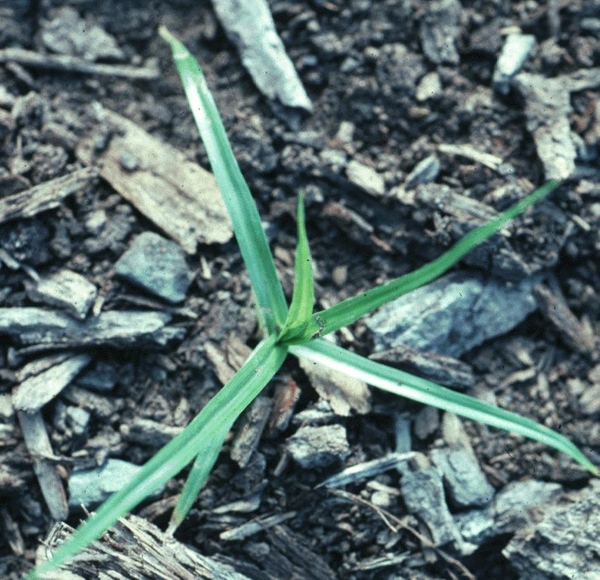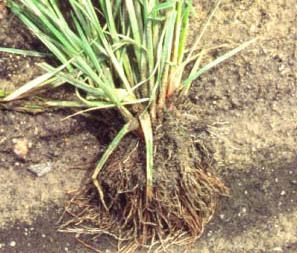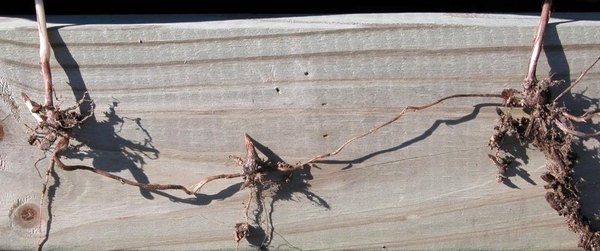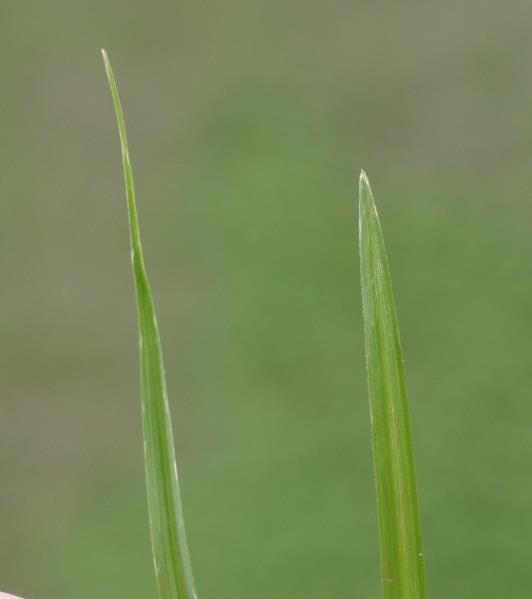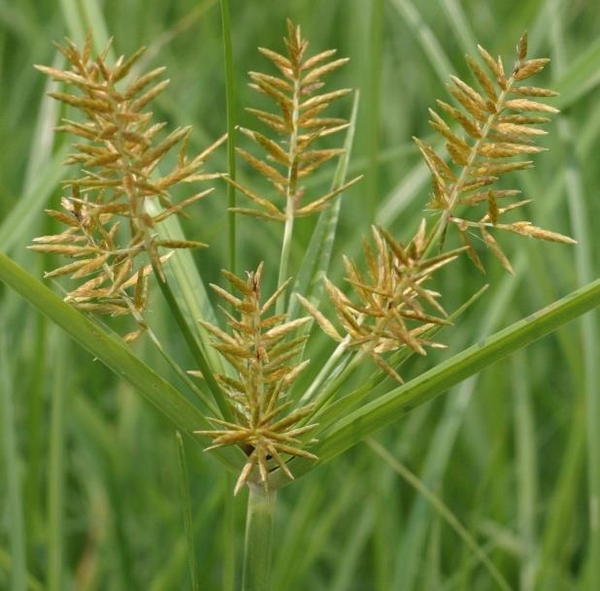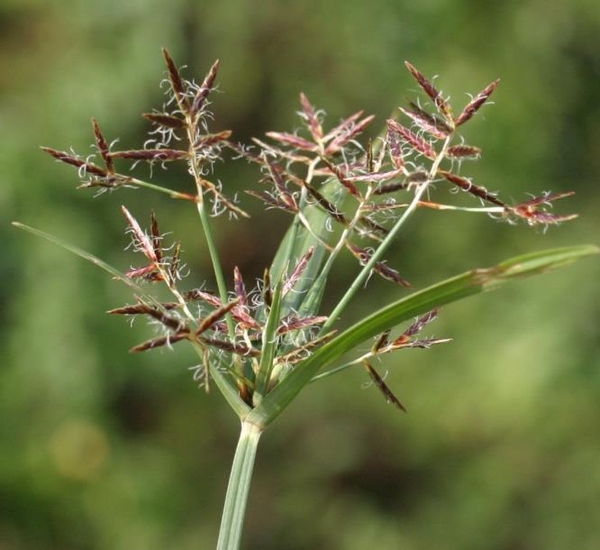About the Weeds
More than 40 sedge species may be found in North Carolina landscapes. Although grass-like in many ways, and the nutsedges are often referred to as “nutgrass”, they are not grasses and require different control measures than grasses. Sedges are easily distinguished from grasses by their leafy shoots that produce leaves in “3s” (Figure 1) resulting in stems that are triangular in cross section (Figure 2). In contrast, shoots of grasses are flat or round in cross section.
While annual sedges are common, the most difficult to manage weedy species are the two perennial nutsedges: yellow nutsedge (Cyperus esculentus) and purple nutsedge (Cyperus rotundus). Yellow and Purple nutsedges can be distinguished from the common annual sedges by the underground parts. Annual sedges will produce a fibrous root system (Figure 3) and a clumping or tillered growth habit; whereas both yellow and purple nutsedge are perennials that produce rhizomes and tubers (Figure 4 and Figure 5) and spread to form colonies. It is the presence of rhizomes and tubers that make these two weeds particularly difficult to manage. Nutsedges are found in nearly all crops and plantings, on nearly all soil types. Yellow nutsedge is more widely distributed and (thankfully) more easily controlled than purple nutsedge. Purple nutsedge is distributed throughout the coastal plain but is much less common in piedmont and mountain regions of North Carolina.
Because purple and yellow nutsedge differ in herbicide susceptibility, distinguishing between them can often be critical to management decisions. Vegetatively, they differ in overall size and vigor, leaf color, leaf tips, and position of the tubers. If growing in the same habitat, yellow nutsedge tends to grow taller than purple nutsedge. Additionally, yellow nutsedge tends to be light-green to yellow-green; purple nutsedge generally is deep green in color. However, unless plants are growing side-by-side, the species will be difficult to differentiate based on color and size. Leaf tips are an excellent diagnostic characteristic. Yellow nutsedge leaf tips have a long, tapered point, whereas purple nutsedge leaf tips are bluntly pointed (Figure 6). Yellow nutsedge forms tubers at the tips of the rhizomes but purple nutsedge tubers are formed in chains on the rhizomes. But, the most reliable way to tell them apart is from the flower heads that differ in color and form. Yellow nutsedge flowers (Figure 7) are yellow-green to tan, while purple nutsedge flowers are deep purple to black, with more slender “branches" (Figure 8).
Plants begin to emerge in the spring; emergence may continue through midsummer. Plants produce leafy clumps of grass-like foliage. During the season, plants spread by fleshy rhizomes (underground stems) which produce “daughter plants.” Starting in early to midsummer, yellow nutsedge begins forming tubers at the tips of the rhizomes. Tubers mature in late July to mid- August. Under optimum conditions, a single yellow nutsedge plant can produce as many as 6000 tubers! Purple nutsedge begins forming tubers earlier than yellow nutsedge, within a few weeks of emergence, and continues to produce tubers in “chains” on the rhizomes until frost. Yellow and purple nutsedge plants flower in mid to late-summer and die with the first hard frost.
While both species can produce viable seeds (nutlets), the principle means of spread and reproduction is by creeping underground stems (rhizomes) and tubers. Most tubers sprout the following spring. Some, however, may remain dormant in the soil for up to 10 years, waiting for an opportunity to germinate. Consequently, nutsedge management strategies must include a long-term commitment to preventing new tuber formation.
Management Guidelines
Tubers of both species are spread by cultivation, introduced in top soil and nursery stock, and persist in the soil for years. Therefore, any management plan should start with sanitation to prevent introduction of tubers by purchasing only “clean” nursery stock and soil amendments. After nutsedge has infested a site, management programs must focus on preventing establishment, spread and new tuber formation.
Preemergence Control
Preemergence control of yellow nutsedge is possible in woody landscape beds with Pennant Magnum (s-metolachlor), Tower (dimethenamid-p) or Freehand (dimethenamid-p plus pendimethalin). Apply Pennant Magnum or Tower before ornamentals break bud, or some foliar injury to ornamentals is likely. Reapply about 8 to 10 weeks later, avoiding contact with tender new foliage. Freehand is a granular herbicide and should be applied when the foliage of ornamentals is dry (to allow granules to roll off the foliage and to the ground). Irrigation following treatment is critical to achieve acceptable yellow nutsedge suppression with any of these herbicides.
Postemergence Control
After nutsedge plants have emerged, postemergence herbicides such as bentazon or halosulfuron are used to control yellow nutsedge and annual sedges. Halosulfuron is also effective on purple nutsedge. Each herbicide is best used as a directed application – avoiding contact with landscape plants. Regardless which product is used, treat early in the season to prevent nutsedge spread and tuber formation.
Basagran TO (a 4 lb per gallon formulation of bentazon) should be applied at 2 lb ai/A (2 qt per acre), with 1 qt per acre of non-phytotoxic crop oil concentrate. The first treatment should be applied in early summer when yellow nutsedge is 6 to 8 inches tall and vigorously growing. If regrowth is observed or new sprouts emerge, repeat the application 7 to 10 days later. A third application is sometimes necessary. Nutsedge control with Basagran TO has been variable — some seasons providing excellent control, other seasons providing fair control. Hot, dry weather tends to reduce weed control. Basagran TO also controls certain seedling broadleaf weeds if applied when annual broadleaves are about 4 to 6 inches tall. Larger weeds will be burned but not controlled. Susceptible weeds include wild buckwheat, dayflower, smartweed, ragweed, common cocklebur and others. Only a few ornamental species tolerate over the top applications of Basagran TO; however, most woody ornamentals are not injured by directed applications. However, do not use around sycamore, taxus or rhododendron as injury from root-uptake has been reported. Also, do not use on herbaceous perennials or bedding plants (except impatiens, marigold, petunia and snapdragon).
Sedgehammer (75% ai dry flowable formulation of halosulfuon) is a relatively new postemergence herbicide, primarily used for yellow and purple nutsedge control in turf. However, it is also labeled for use as a directed application around established woody ornamentals. It is used in very low doses — 0.67 to 1.3 oz. of product per acre. It is available in convenient, water soluble packets. Just add one water soluble bag to 1 gal of water in a backpack or hand-held sprayer; shake well; add 2 tsp of non-ionic surfactant; shake it again; and you are ready to spray about 1000 ft2. Apply the first treatment in late May or early June to young nutsedge sprouts when plants have 3 to 8 leaves (delaying this first application tends to result in less control). Re-apply 6 weeks later for season-long control. Two applications at 0.67 oz. have provided more consistent control than a single, 1.3 oz applications. Always add 0.5% (by volume) non-ionic surfactant with Sedgehammer applications. Do not exceed two applications per year. Contact with the foliage of ornamental plants should be avoided, as Sedgehammer can injure certain species including (but not limited to) arborvitae and taxus. Do not use Sedgehammer around herbaceous perennials or annual flowers.
Directed and spot applications of non-selective, postemergence herbicides such as glufosinate or glyphosate may be used to kill existing yellow or purple nutsedge plants. Yes, contrary to popular opinion, glyphosate and glufosinate control nutsedge very well. Over the past 40 years I have tested this many times.. with the same results. Both glyphosate and glufosinate control nutsedge. Whichever herbicide is selected, avoid all contact with desirable vegetation. A full discussion of postmergence, non-selective herbicides is available in Horticulture Information Leaflet No.648.
Nutsedges are persistent weeds that will return year after year; therefore, any nutsedge management plan will require several years of sustained effort to rid the landscape of these pesky weeds. Once clean, sanitation to prevent new introductions is critical. Any new infestations should be controlled right away to prevent spread of these aggressive and difficult-to-control pests.
For more information, consult herbicide labels and your local Cooperative Extension office. For control guidelines in turfgrass, check out the online guidelines on the TurfFiles web portal.
Publication date: Dec. 31, 1998
Reviewed/Revised: Jan. 1, 2013
Recommendations for the use of agricultural chemicals are included in this publication as a convenience to the reader. The use of brand names and any mention or listing of commercial products or services in this publication does not imply endorsement by NC State University or N.C. A&T State University nor discrimination against similar products or services not mentioned. Individuals who use agricultural chemicals are responsible for ensuring that the intended use complies with current regulations and conforms to the product label. Be sure to obtain current information about usage regulations and examine a current product label before applying any chemical. For assistance, contact your local N.C. Cooperative Extension county center.
N.C. Cooperative Extension prohibits discrimination and harassment regardless of age, color, disability, family and marital status, gender identity, national origin, political beliefs, race, religion, sex (including pregnancy), sexual orientation and veteran status.

